Tech
Articulated Dump Trucks Using Tech to Go Easier on the Operator
Published
2 years agoon
By
admin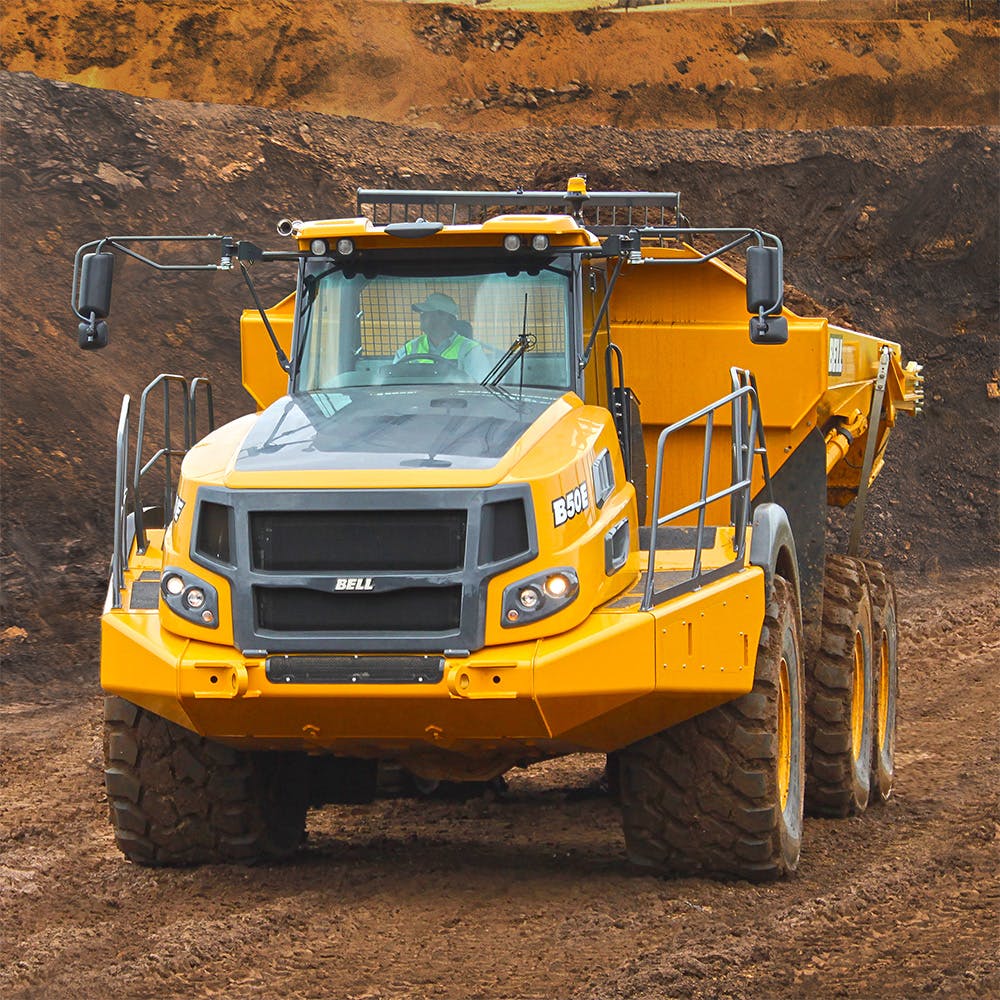
Articulated dump trucks continue to advance technologically, as manufacturers develop new ways to make life easier and more productive for operators in these days of debilitating labor shortages.
Artics now come equipped with such features as pedestrian detection, automatic systems to increase traction and to reduce speed on hill descents, and assisted hoist for reducing some of the repetitive motions of dumping.
Telematics are delivering real-time data to help improve productivity. Some OEMs are also increasing service intervals for time and cost savings.
Here’s a look at what’s new and improved with artics.
Autonomy: ‘not merely a concept’
 The Bell 50E has a Mercedes-Benz engine rated at 543 net horsepower. The seven-speed transmission is an Allison 4800 ORS. Tires are 875/65 R29, which Bell says is a completely new design with a higher capacity, “making the B50E the first true 50-ton truck.” Optional are 29.5 R25 tires. Struck capacity at 2:1 is 36 cubic yards.Bell EquipmentNick Kyriacos, ADT product marketing manager with Bell Equipment, said the company has worked to integrate responsibility to the environment, to society and to the customer.
The Bell 50E has a Mercedes-Benz engine rated at 543 net horsepower. The seven-speed transmission is an Allison 4800 ORS. Tires are 875/65 R29, which Bell says is a completely new design with a higher capacity, “making the B50E the first true 50-ton truck.” Optional are 29.5 R25 tires. Struck capacity at 2:1 is 36 cubic yards.Bell EquipmentNick Kyriacos, ADT product marketing manager with Bell Equipment, said the company has worked to integrate responsibility to the environment, to society and to the customer.
“We’re part of a green revolution but we’ve found ways to serve both the environment and the customer at the same time,” he says.
All Bell trucks run on Mercedes-Benz engines and Allison transmissions to maximize production efficiency while also adding the convenience and cost-effectiveness of commonality to their line.
Similarly, the company uses providers for its autonomous systems rather than develop its own.
In North America, it uses Pronto AI. The pedestrian detection system is also outsourced. The key to integrating these systems is sophisticated and adaptable electronics.
“To demonstrate the power and flexibility of the circuitry on our trucks,” says Kyriacos, “we operated a truck with an Xbox controller at distances of up to 20 meters.”
The same sophisticated technology is what makes “autonomous operation a fact, not merely a concept,” says Robin Pett, product manager. “We have sites in the U.S. where all the machines are communicating with each other. Even a pickup that drives onto the site has a communication beacon.”
Autonomous operation improves efficiency, says Kyriacos. “Suppose the site design and loading tool dictate that 3.2 trucks is the optimal number of trucks to have. With three trucks, the loader operator sits idle at times. With four trucks, the truck operators sit idle. Autonomous operation manages truck speed and other factors to eliminate unnecessary idling by anyone, to save fuel and wear and maximize productivity.”
Payload monitoring has been standard on Bell trucks since 2002. The system now includes inclinometers to compensate for the pitch of the truck while loading because pitch can alter the pressure on payload sensors.
The inclinometers also help with hill assist and hill hold. With hill hold, for example, the system knows the pitch and the load and determines the torque required to create movement under those conditions. The system will not release the service brakes until sufficient torque is provided to the wheels, which virtually eliminates rollback.
Removing the drudgery
 The Cat 730 has a payload of 31 tons and a capacity of 23 cubic yards in a 2:1 heap. A Cat C13 engine rated at 370 net horsepower requires no de-rating to 12,500 feet. The transmission has six forward and one reverse gear. The spacious cab has a sound level of just 72dB(A), while the combined hoist and transmission lever cuts operator input in half.CaterpillarCaterpillar has had Automatic Traction Control since 2011. Cat doesn’t apply the service brakes to the slipping wheel; doing so creates unnecessary wear. Instead, the system varies the oil flow to the clutch pack in each wheel motor to control slip – more oil, more torque; less oil, less torque.
The Cat 730 has a payload of 31 tons and a capacity of 23 cubic yards in a 2:1 heap. A Cat C13 engine rated at 370 net horsepower requires no de-rating to 12,500 feet. The transmission has six forward and one reverse gear. The spacious cab has a sound level of just 72dB(A), while the combined hoist and transmission lever cuts operator input in half.CaterpillarCaterpillar has had Automatic Traction Control since 2011. Cat doesn’t apply the service brakes to the slipping wheel; doing so creates unnecessary wear. Instead, the system varies the oil flow to the clutch pack in each wheel motor to control slip – more oil, more torque; less oil, less torque.
Automatic Retarding Control is fully automatic. Sensors tell the system if the truck is going downhill, the gear position, speed and whether the truck is loaded.
When the operator’s foot comes off the accelerator on a descent, the system engages ARC at the level dictated by conditions. If more slowing power is needed, ARC will apply the service brakes and, if needed, execute a downshift while still protecting the engine from overspeeding.
Stability assist sounds a continuous alarm if the side slope exceeds 15%. The percent of grade needed to trigger the alarm can be set by the operator. It will also inhibit hoist actuation under these conditions. Stability assist is on all models from 725 through 745, including GC models.
“The most popular feature among drivers is assisted hoist,” says Scott Thomas, Cat production application specialist, “which automates the dump cycle.”
If the truck is stopped or traveling less than 2 mph and the driver engages assisted hoist by the feature’s fingertip control, the truck will automatically shift to neutral, apply the service brakes and raise the bed. Assisted hoist is available with the gear selector in any position.
“Assisted hoist takes the drudgery out of a repetitive operation,” says Thomas.
Real-time productivity monitoring
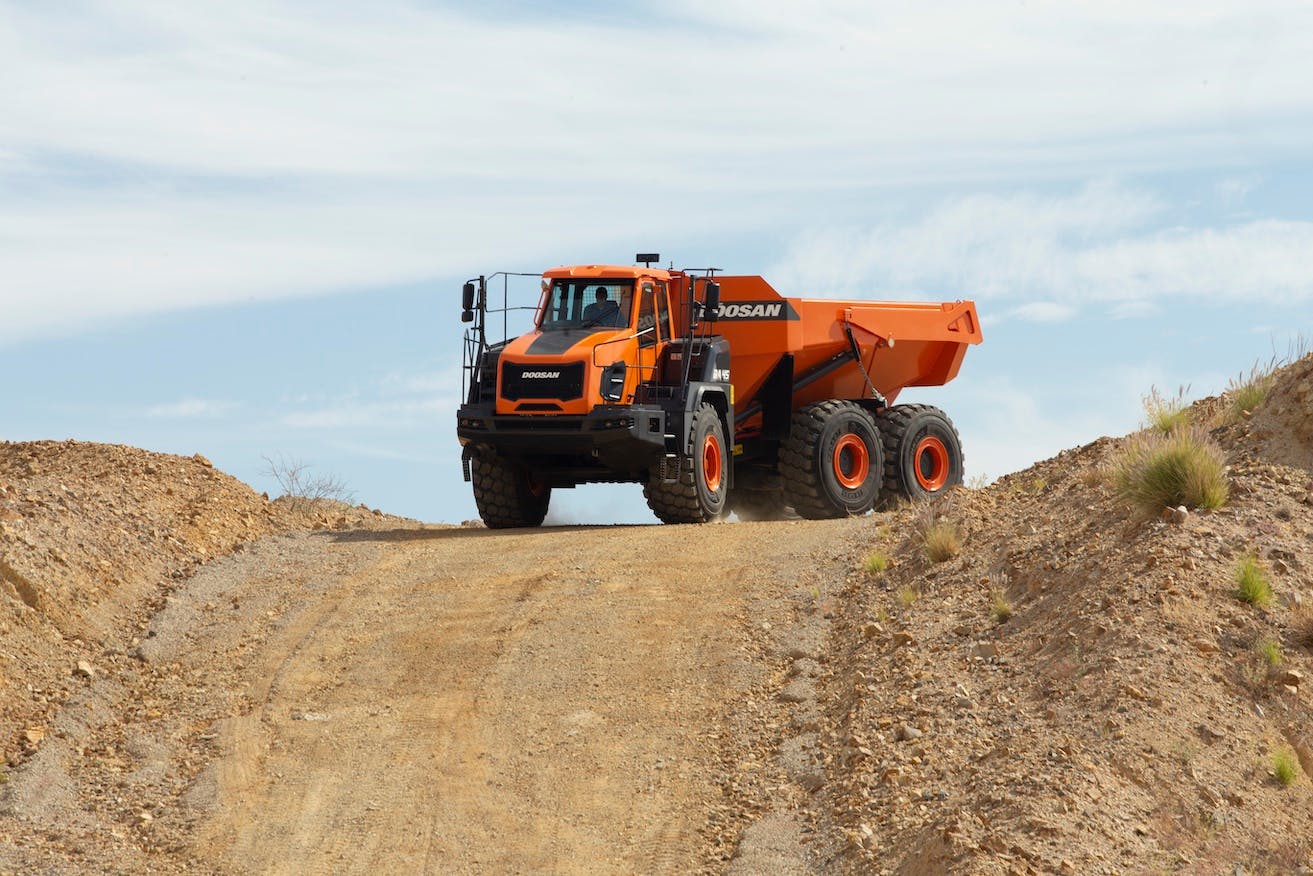 The rated payload of the Doosan DA45-5 is 90,390 pounds, and the body volume is 31.9 cubic yards. Net horsepower is 483, and the transmission has eight forward and four reverse speeds. Overall width is under 12 feet for easier transport. The cab features fully automatic climate control, air suspension seating, excellent visibility and low noise levels.DoosanDoosan continues with its proven design on its DA30-5 and new DA45-5, which replaces the DA40-5. Among the key features is a forward-mounted turning ring that minimizes any tendency for the truck to push forward instead of turning when loaded and better balances payload in turns. The sloping rear frame also helps distribute the load.
The rated payload of the Doosan DA45-5 is 90,390 pounds, and the body volume is 31.9 cubic yards. Net horsepower is 483, and the transmission has eight forward and four reverse speeds. Overall width is under 12 feet for easier transport. The cab features fully automatic climate control, air suspension seating, excellent visibility and low noise levels.DoosanDoosan continues with its proven design on its DA30-5 and new DA45-5, which replaces the DA40-5. Among the key features is a forward-mounted turning ring that minimizes any tendency for the truck to push forward instead of turning when loaded and better balances payload in turns. The sloping rear frame also helps distribute the load.
The free-swinging tandem rear bogie remains in use. The design yields better tracking in extreme terrain and, with a single-drive axle, has fewer moving parts than other designs. Tractive force is so good that drivers can back farther up a pile before dumping, “in some cases eliminating the need for a dozer to build the pile,” says Aaron Kleingartner, dealer and product marketing manager, Doosan Infracore North America.
Limited-slip differentials and a lockable interaxle differential further improve traction. The hydraulic retarder engages automatically and can be set by the operator in 25% increments.
Kleingartner says the use of telematics, such as DoosanConnect, has matured. Once relied upon for simple tasks such as geofencing and recording fuel use, telematics are now used in real-time to monitor and improve productivity.
And electronic trucks?
“We continue to advance in that direction as motor and battery designs improve,” says Kleingartner. Doosan also continues to develop its Concept-X platform of the autonomous jobsite.
Payload meter now standard
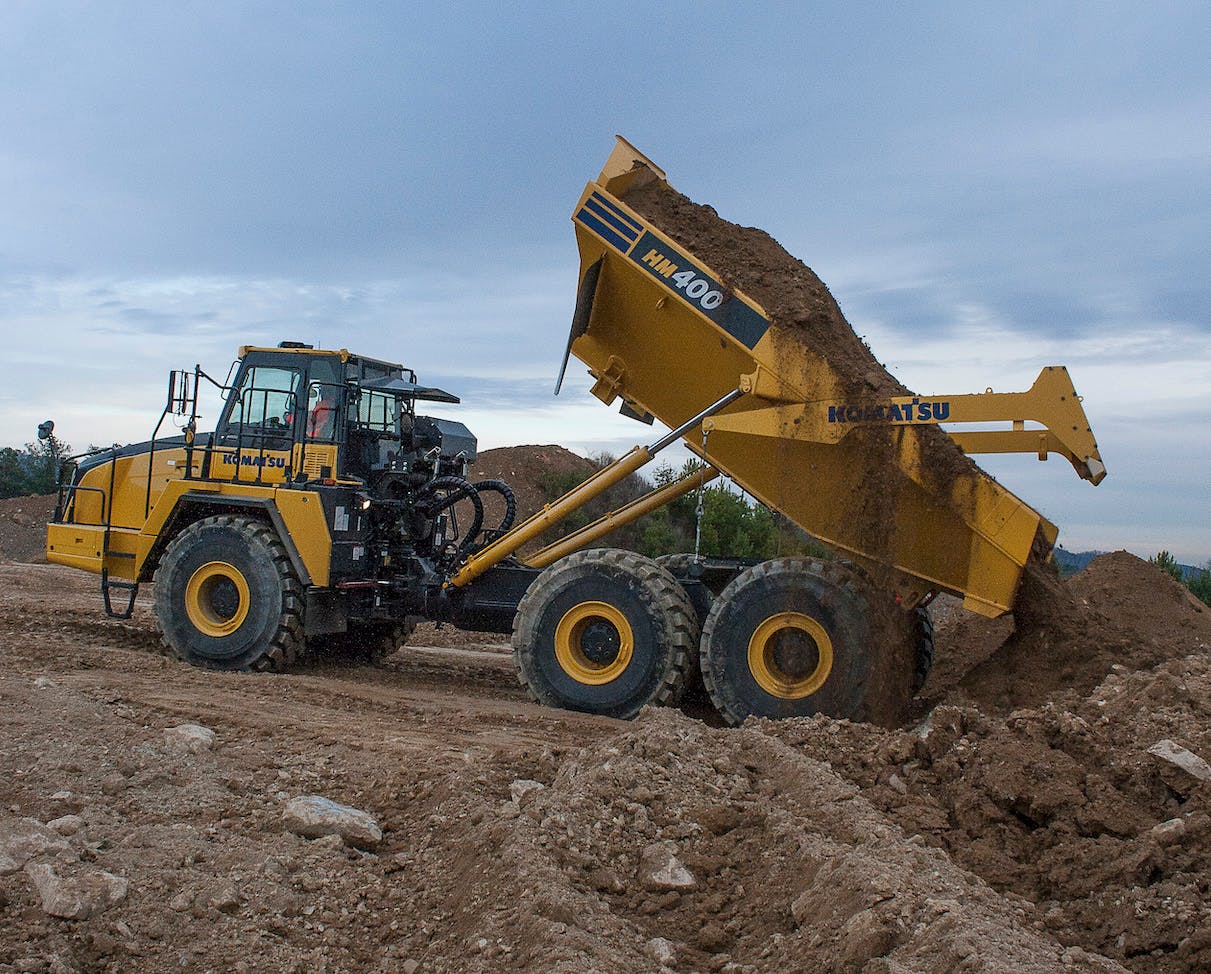 Capacity of the Komatsu HM400-5 is 44.1 tons. Power comes from a Komatsu SAA6D-140E-7 engine rated at 466 net horsepower and 1,669 pound-feet of torque. The fully automatic, countershaft transmission has six forward and two reverse speeds. Torque converter drive is used in first gear; first-gear lockup and all other gears use direct drive.KomatsuRobert Hussey, product manager with Komatsu, offered two new features and two existing features he believes may be underappreciated.
Capacity of the Komatsu HM400-5 is 44.1 tons. Power comes from a Komatsu SAA6D-140E-7 engine rated at 466 net horsepower and 1,669 pound-feet of torque. The fully automatic, countershaft transmission has six forward and two reverse speeds. Torque converter drive is used in first gear; first-gear lockup and all other gears use direct drive.KomatsuRobert Hussey, product manager with Komatsu, offered two new features and two existing features he believes may be underappreciated.
First of the new features is a common dump body. In the past, customers had to specify whether they wanted a heated or non-heated body setup. Now all Komatsu articulated truck bodies come with exhaust heat channels installed from the factory. The customer still specs the desired body setup when ordering, but bodies can be converted at any time with an exhaust reroute kit. This is especially valuable for customers who move into colder markets with their existing trucks; it also increases residual value in the secondary market.
The second new feature is the Automatic Retarder Accelerator Control. All slowing is done using the service brakes; there is no engine brake or transmission retarder.
ARAC engages at 4.3 mph on descents when the operator’s foot comes off the accelerator. Oil flow is increased to the brakes when ARAC is activated.
Before ARAC, the operator maintained speed using a manual retarder lever; that lever is still in place and allows the operator to increase slowing effort above what is provided by ARAC when needed.
The first of the two existing features Hussey wants to emphasize is the Komatsu payload meter. It was optional on previous models and is now standard on Dash-5 trucks.
“The system is more advanced than it is generally given credit for,” says Hussey. “It provides a lot of data to a lot of people seamlessly, simultaneously.” Information is provided via the in-cab monitor, indicator lamps mounted on the truck, and Komtrax telematics to the truck operator, the loader operator and management, respectively.
The load lights are green, yellow and red but can also be off, flashing or steady. The optimal load is when the green and yellow lights are steady on, and the red light is flashing.
The payload meter system controls the lights based on the effects on payload of previous passes from the loader in the current loading cycle. The system resets at the dump cycle. Payload information is transmitted after the truck has traveled 525 feet, to provide more accurate data; that standard is user-settable for sites with shorter haul distances.
Hussey also calls attention to the Komatsu Traction Control System, which uses the service brakes for controlling wheel slip. This reduces tire wear compared to locking differentials. There is a locking interaxle differential that can be set to engage automatically or manually as conditions require.
New name, long history
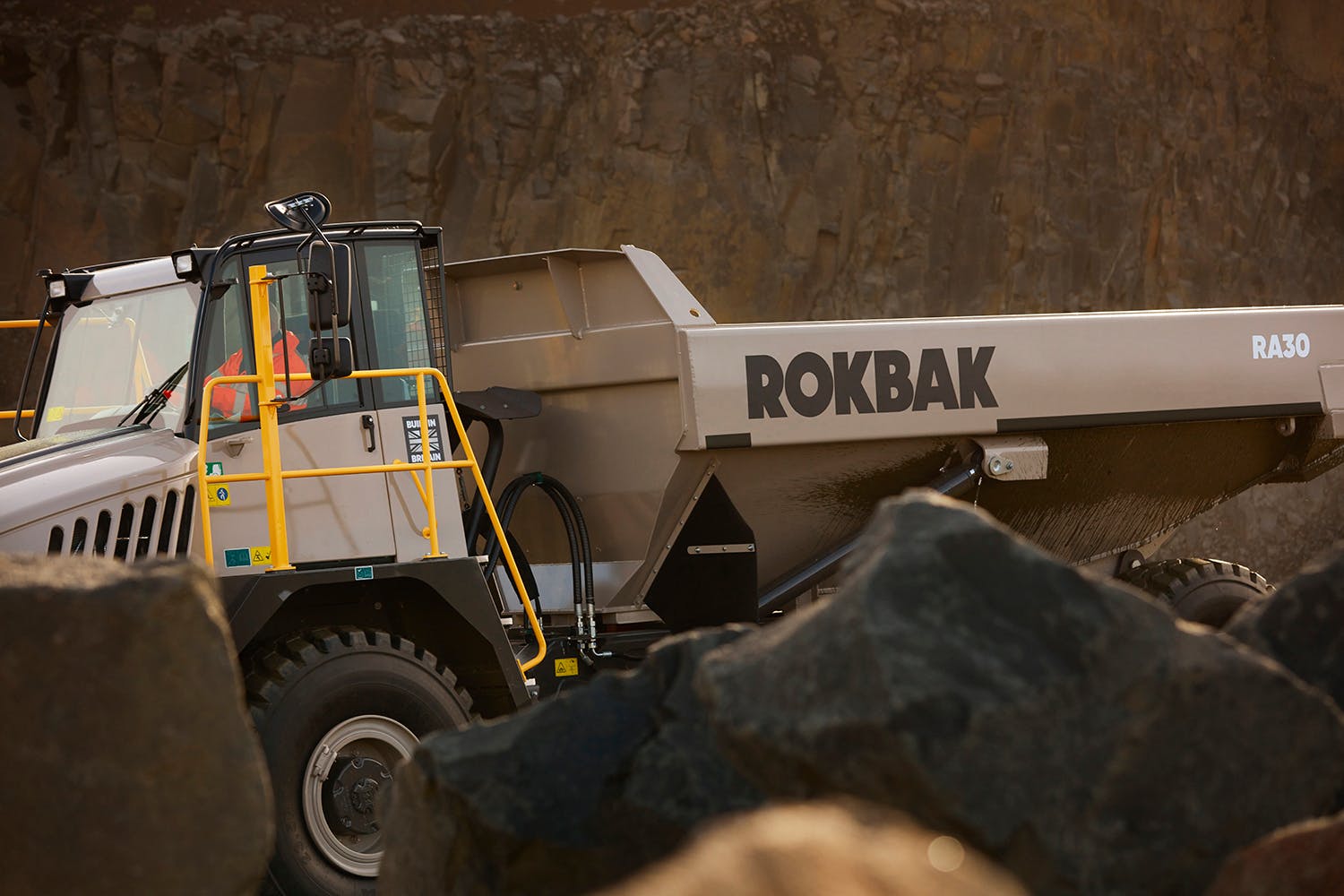 There are two models in the Rokbak line. The RA30 has a maximum payload of 30.9 tons, a heaped capacity of 22.9 cubic yards and an engine rated at 370 horsepower. Specs for the RA40 are 41.9 tons, 30.3 cubic yards and 444 horsepower. Comfort features include a high-back seat with adjustable air suspension and adjustable armrests, premium HVAC with optimal airflow and clear instrumentation and LCD display.RokbakVolvo Group purchased the Terex hauler product lines and the Motherwell, Scotland factory in 2014. Terex Trucks has now been rebranded Rokbak by parent company Volvo Construction Equipment, a subsidiary of Volvo Group.
There are two models in the Rokbak line. The RA30 has a maximum payload of 30.9 tons, a heaped capacity of 22.9 cubic yards and an engine rated at 370 horsepower. Specs for the RA40 are 41.9 tons, 30.3 cubic yards and 444 horsepower. Comfort features include a high-back seat with adjustable air suspension and adjustable armrests, premium HVAC with optimal airflow and clear instrumentation and LCD display.RokbakVolvo Group purchased the Terex hauler product lines and the Motherwell, Scotland factory in 2014. Terex Trucks has now been rebranded Rokbak by parent company Volvo Construction Equipment, a subsidiary of Volvo Group.
Why?
“Managing brand names is common at Volvo,” says Scott Pollack, senior product manager, Rokbak. “We wanted a unique name while at the same time carrying forward the long history of technology and innovation established by the Terex Trucks brand.”
Examples of features carried forward include the hydraulic tilt cab and electric tilt hood.
With Rokbak models, PM intervals are longer – up to 4,000 hours on the RA30 and up to 6,000 hours on the RA40 for transmission fluid and filter changes. This and the use of semi-synthetic transmission fluid reduces transmission costs by up to one-third.
The standard Rokbak warranty in North America is three years, 3,000 hours, and three years, 6,000 hours on the powertrain. A maintenance plan and Haul Track telematics subscription are available on registration; each is for three years or 3,000 hours.
Comfort features on Rokbak trucks include a semi-pressurized cab, improved HVAC with better temperature control, and an air-ride seat with three user-settable suspension rates.
Other features include on-board weighing as part of the optional Haul Track telematics package and inclinometers on the dump body to help prevent tip-over.
Cutting time, money on preventive maintenance
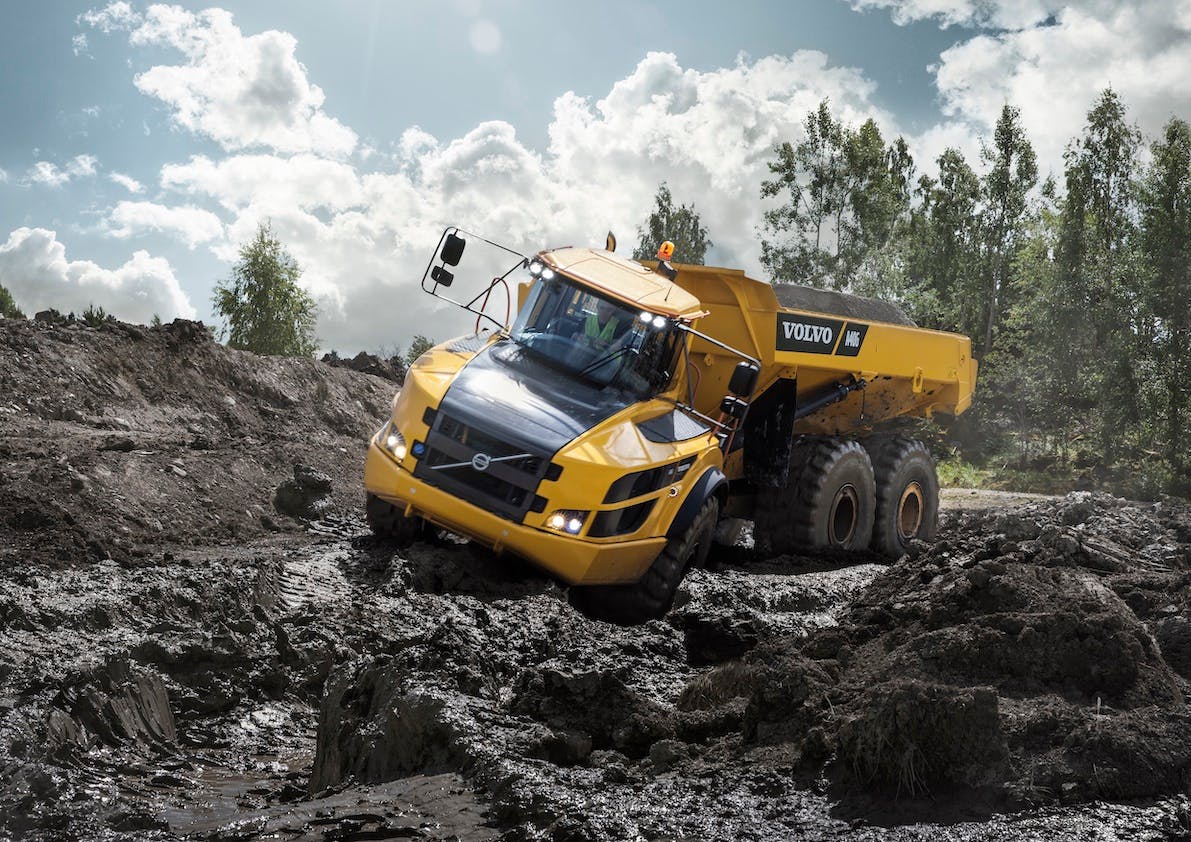 Payload capacity for the Volvo A40G is 43 tons. Body volume at a 2:1 heap is 31.4 cubic yards. The Volvo D13J engine is rated at 469 gross horsepower and 1,862 pound-feet of torque. Volvo Dynamic Drive and predictive gear selection adapt to operating conditions for improved comfort and fuel efficiency. It also features cruise control, hill assist, hill hold and OptiShift.Volvo CEVolvo CE extended engine oil and filter change intervals from 500 to 1,000 hours. The key to this is the use of 1,000-hour approved oils, such as Volvo VDS-4.5.
Payload capacity for the Volvo A40G is 43 tons. Body volume at a 2:1 heap is 31.4 cubic yards. The Volvo D13J engine is rated at 469 gross horsepower and 1,862 pound-feet of torque. Volvo Dynamic Drive and predictive gear selection adapt to operating conditions for improved comfort and fuel efficiency. It also features cruise control, hill assist, hill hold and OptiShift.Volvo CEVolvo CE extended engine oil and filter change intervals from 500 to 1,000 hours. The key to this is the use of 1,000-hour approved oils, such as Volvo VDS-4.5.
A new quick-fit system enables cleaner, faster oil changes. New handles on both sides of the counterweight make service points easier to access. Improvements to PM practices will cut maintenance costs and scheduled downtime up to half without compromising component performance or longevity, the company says.
A tire pressure monitoring system is now standard on Volvo A35G, A40G, A45G, A45GFS and A60H haulers; it is optional on the A25G and A30G. Tire information is shown on the Volvo Co-Pilot in-cab tablet display.
TPMS is a good tool, but proper tire management starts with tire selection, says Eric Fatyol, product manager, articulated haulers, Volvo Construction Equipment. “You’ll typically replace all six tires at one time, and selecting the right size for your application is important, especially when it comes to standard versus high-flotation tires.”
He says the standard tires are fine for most applications; high-flotation tires are preferred in softer conditions, such as wet mud or clay. On an A40G or A45G, the standard tire would be a 29.5R25 and a high-flotation tire would be an 875/65R29.
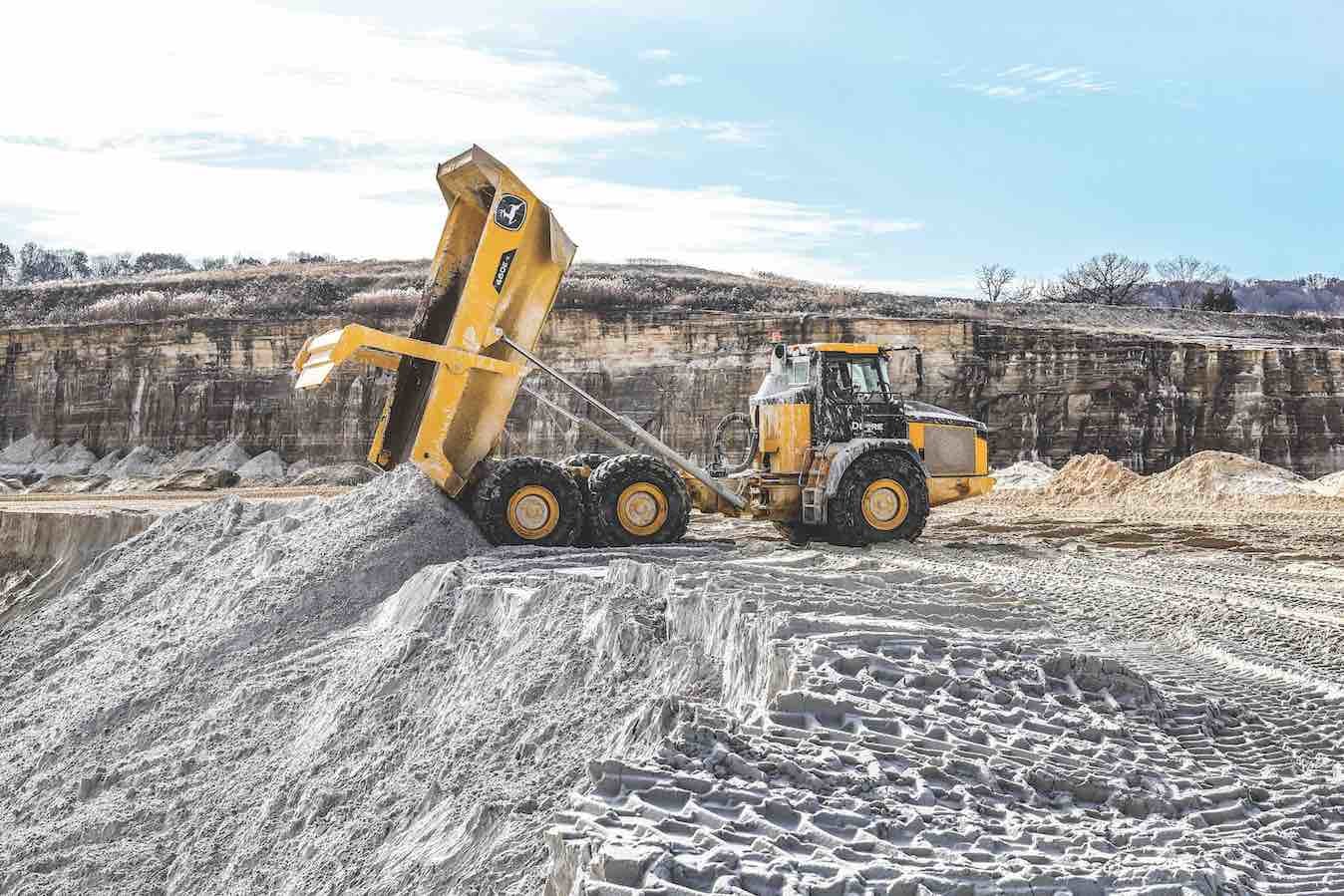 The 410E-II and 460E-II (shown above) models from John Deere represent an evolution of the E Series. Fuel consumption has dropped as much as 7%. The redesigned dump body is wider and has a lowered and leveled rail height for better material retention. Controls are simplified; a single sealed switch model reduces the number of switches by 25%, and an automotive-style multifunction turn-signal stalk has controls for the lights and windshield wipers.John Deere
The 410E-II and 460E-II (shown above) models from John Deere represent an evolution of the E Series. Fuel consumption has dropped as much as 7%. The redesigned dump body is wider and has a lowered and leveled rail height for better material retention. Controls are simplified; a single sealed switch model reduces the number of switches by 25%, and an automotive-style multifunction turn-signal stalk has controls for the lights and windshield wipers.John Deere
You may like
-


Hyundai to Reenter Compact Market at Conexpo 2023
-


Doosan Changes Its Brand Name to Develon
-
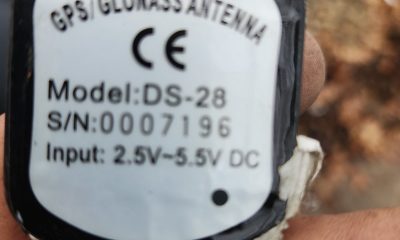

Contractor tracks down stolen skid steer, finds theft ring
-


Top 40 construction equipment stories of 2022
-


Kubota unveils UTVs for 2023 with new colors, accessories
-
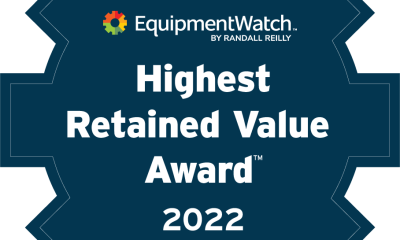

Finalists named for EquipmentWatch Highest Retained Value Awards
Tech
Cat’s Next Generation 255 and 265 Get More Power, Lift Height
Published
7 months agoon
October 10, 2023By
admin
Caterpillar is bidding farewell to its 259D3, 279D3 and 289D3 compact track loaders with the introduction of its new, next-generation 255 and 266 models.
The completely redesigned models debuted at media and customer events at Caterpillar’s Edwards, Illinois, Demonstration and Learning Center last week. The 255 and 265 offer improved engine performance, more lift height, a roomier cab and more standard technology than their predecessors.
“We kept the DNA of the D3 series while reimagining the possibilities of loader performance using voice of customer feedback to lead the way,” says Trevor Chase, product application specialist for Caterpillar. “Both next-generation models leverage the many benefits offered by the vertical lift design. The new Cat 255 replaces the 259D3, while the 265 replaces both the 279D3 and 289D3 machines.”
The CTLs are the last of Cat’s building and construction products to get the next-generation treatment and simplified nomenclature. The first number (2) represents the skid steer loader and compact track loader machine family; the middle number (5 or 6) designates the machine size; and the ending number (5) is the compact track loader identifier. Skid steers will be identified by a 0 end number. Additional new models will roll out in the coming months, the company says.
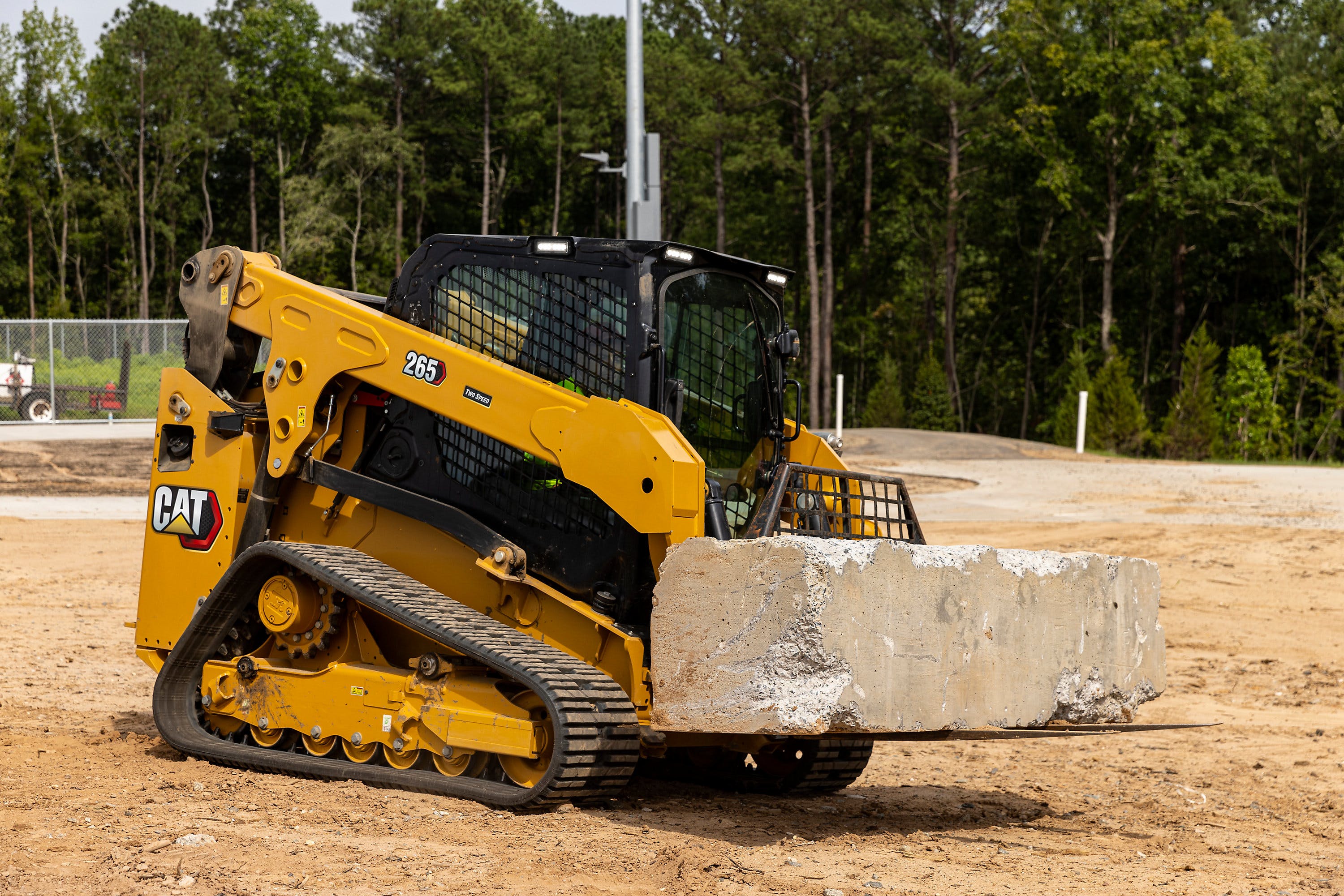 CaterpillarMore power and torque
CaterpillarMore power and torque
Cat equipped the 255 with a C2.8T engine and the 265 with a C2.8TA engine, both at 74 horsepower. This gives the new machines a significant boost in torque – 13% for the 255 and 43% for the 256 – over their D3-Series predecessors. The engine and cooling package are mounted lower in the frame for added visibility out the rear window and stability while lifting heavy loads.
Customers attest that the added lift height makes truck loading easier. The 255 offers 10 feet 4 inches of lift height, while the 265 can reach 11 feet high.
“The lift height has made a big difference when loading trucks,” said Derrick Roger, owner of Coast to Coast Lawnscapes, who spent several months testing the 255. “You can get on top of that truck now and empty the bucket; whereas, before you would have to shake the bucket to try to get the material to fall out.”
The 255 delivers 36% more tilt breakout, 26% higher lift breakout force and a 24% increase in rated operating capacity (ROC). The 265 also delivers 19% higher tilt breakout force and 22% higher lift breakout force.
Standard hydraulic pressure has been increased to 3,500 psi, allowing the 255 and 265 to operate all Cat Smart Attachments with the standard auxiliary hydraulics provided.
If demanding attachments require additional hydraulic flow, customers can have their Cat dealer activate the high flow functionality on the machine or remotely via software update. This makes it possible for the CTLs to hit 30 gallons per minute of flow at the standard system pressure.
A High Flow XPS factory option increases auxiliary hydraulic system pressure to 4,061 psi for both models, while also increasing the hydraulic flow to 30 gallons per minute for the 255 and 34 gallons per minute for the 265.
The torsion suspension undercarriage delivers better operator comfort, track wear and material retention, plus the stiffer design results in smoother graded surfaces, Cat says. A new 12.6-inch bar-tread narrow track option is available on the 255.
A more spacious cab
Cat says it has increased the cab width by 2.75 inches without making the machines wider and the footwell-to-ceiling height by 1.8 inches. The larger cab gives operators an additional 1.5 inches of hip room and 1.1 inches more width between the joysticks.
A range of new mechanical and air-ride suspension seat options are available, including a ventilated and heated seat. A new automatic temperature control allows operators to set a specific temperature. Relocated vents help cool or heat the machine quickly.
The standard package includes the same 5-inch LCD monitor as the D3 Series CTLs, which offers Bluetooth connectivity and functionality for the rearview camera feed, creep, job clock, and maintenance reminders.
Customers can upgrade to a new 8-inch advanced touchscreen monitor, like the display found in Cat’s next-generation mini excavators and small loaders. It delivers advanced radio control and supports the 270-degree multicamera option. The advanced monitor pairs with the advanced joysticks for integrated control of all machine functions and adjustments.
“You can adjust the movement – or the aggressiveness or the conservativeness – of how your tracks and lift arms work through your advanced touchscreen display,” Dante Thomas, skid steer and CTL marketing manager, said. “And you can control of all of your display functions from the advanced joysticks. There are buttons with enter and select functions on those joysticks that you’re able to change any functionality that is possible.”
Cat also redesigned the entry, making the 255 and 265 easier to enter and exit. The cab door can be opened even when the lift arms are not fully lowered to the frame stops. It can be removed without tools in less than one minute.
Advanced technologies
Calling the 255 and 265 “one of the most attachment-friendly machines on the market,” Thomas says both the standard and advanced monitors can run Cat Smart Attachments, such as the dozer and grader blades and backhoe.
“It has attachment recognition that when you plug the attachment into the machine, it recognizes which attachment is connected. It adjusts your joystick pattern, so it gives you intuitive and simple control,” says Thomas.
The available Cat Product Link Elite system tracks machine hours, location, asset utilization, provides fault code details and delivers advanced monitoring and machine health, that is remotely accessible via VisionLink. In addition, Product Link Elite provides remote flash and troubleshooting capabilities and quickly enables the remote activation of the SEA High Flow feature.
[embedded content]
Tech
Quick Data: 2023 Top-Selling Wheel Loaders and Auction Trends
Published
7 months agoon
October 9, 2023By
admin
Quick Data is a snapshot of new and used wheel loader sales trends from Randall Reilly’s EDA equipment financing data, TopBid auction price service and EquipmentWatch market trend reports.
Demand for wheel loaders has softened with new and used financed wheel loader sales down year-over-year from August 1, 2022 to July 31, 2023 according to Randall Reilly’s EDA equipment financing data.
Financed new wheel loader sales dropped 10%, while used financed wheel loader sales fell by 15% compared to the same period last year.
Cat (22.4%), Deere (21.0%) and Komatsu (12.4%) held their positions year-over-year as the top three sellers of new financed wheel loaders. Top models sold included the Deere 544 P-Tier (401), Deere 624 P-Tier (380) and the Komatsu WA270-8 (364).
[Watch: “A Really Solid Machine” – Test Run of Komatsu’s WA475-10 Wheel Loader]
Cat (28.5%) and Deere (22.9%) also snagged the No. 1 and 2 positions for the highest number of financed used units sold, with Case (14.7%) claiming the third spot. On the date we examined the data, the top-selling models were the Case 321F (340), Cat 926M (164) and the Case 621G (159).
During this period, there were more buyers of new loaders in Florida (955) than in any other state. Buyers of new wheel loaders were also prevalent in Texas (893) and Illinois (665). Those states were also top buyers of used financed machines, with 712 units sold in Texas, 413 in Florida, and 412 in Illinois.
EDA data is compiled from state UCC-1 filings on financed construction equipment. EDA continually updates this data as information comes in from each state.
[Related Content: A Rundown of the Latest Wheel Loaders for 2023]
Used Wheel Loader Market
Used wheel loader prices rose 10.1% for the 12-month period from August 1, 2022 to July 31, 2023, according to Randall Reilly’s EquipmentWatch market trend data.
The average price for a used wheel loader was $137,465 in July 2022 compared to $151,367 in July 2023. The average age of used wheel loaders fell slightly during the period, dropping from 8.8 years to 8.3 years.
 EquipmentWatchThe average age and price were calculated on 153,356 resale listings during the period in the EquipmentWatch database.
EquipmentWatchThe average age and price were calculated on 153,356 resale listings during the period in the EquipmentWatch database.
Over the last 12 months, prices for used wheel loaders have in general increased, with the largest gains in October 2022 (6.5%) and February 2023 (2.9%).
EquipmentWatch defines fair market value (FMV) as the monetary value of an asset that can be expected in a transaction with a single seller and single buyer, neither of whom is under any compulsion or time restriction to complete the transaction. FMV for heavy equipment is most closely associated with the private resale market, as opposed to the public auction market.
Wheel Loader Auction Prices
Caterpillar also dominated the auction charts, accounting for 18 of the top 20 wheel loaders sold in terms of price for the 12-month period of September 1, 2022 to August 31, 2023. Deere and Komatsu were the only other manufacturers to appear on the list.
The top auction price spot went to a 2021 Cat 966M with 2,188 hours. It sold for $400,000 at a Ritchie Bros. auction in Orlando, Fla., on September 21, 2022. The second-highest price paid was $315,000 for a 2019 Cat 980M with 7,836 hours at another Ritchie Bros. sale in Atlanta, on December 1, 2022. Rounding out the top three was a 2018 Deere 944K with 8,941 hours. It sold for $290,00 at a J.M. Wood Auction Co. sale in Montgomery, Ala., on March 21, 2023.
In total, there were 358 wheel loaders sold at auctions tracked by Top Bid during this time, with an average price of $99,747. (This does not include any units sold for less than $5,000.)
EDA, Top Bid and EquipmentWatch are owned by Randall Reilly, parent of Equipment World.
[Related Content: Heavy Equipment Auctions Set for Second Half of 2023]
Tech
Video: A closer look at Rokbak articulated dump trucks
Published
7 months agoon
October 6, 2023By
admin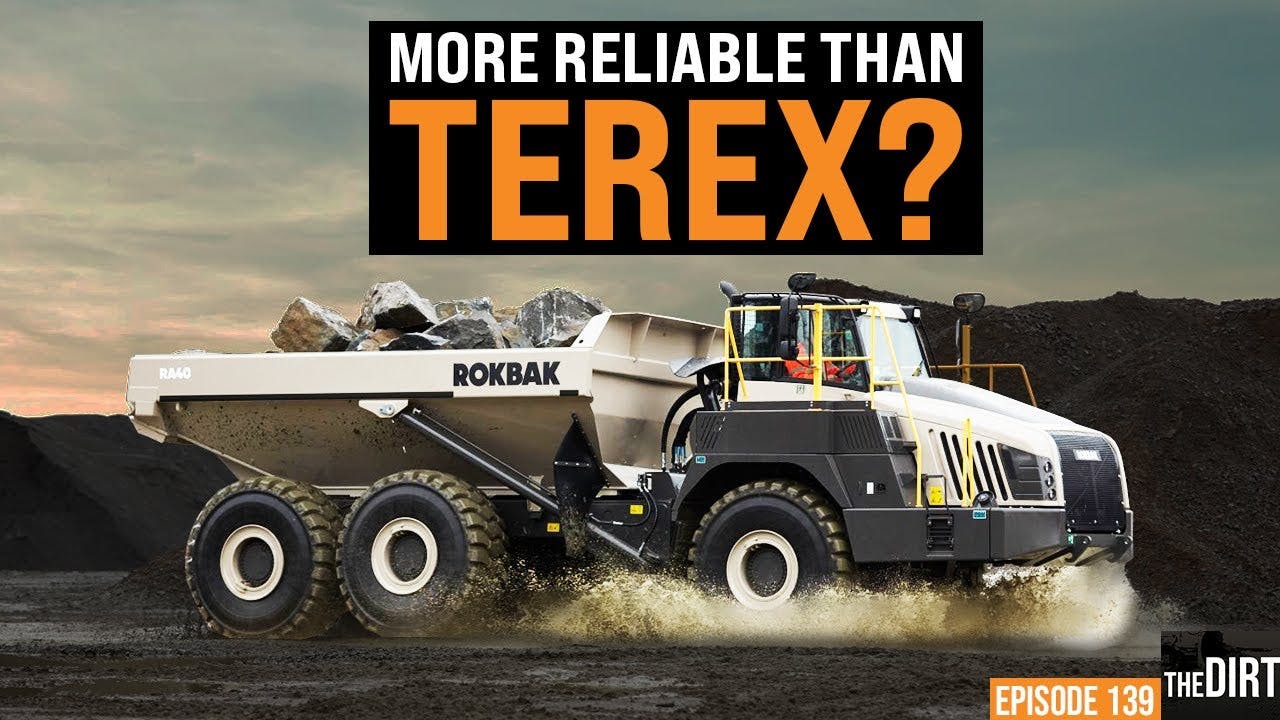

Volvo Construction Equipment bought Terex’s off-road truck line in 2014, and six years later, it rebranded its articulated haulers under the Rokbak name.
On this episode of The Dirt, we hear from Paul Douglas, Volvo vice president of rigid haulers, who explains the differences between the old Terex line and the Rokbak trucks. He also gives a hint at some of the new things coming from Rokbak, including redesigned cabs and replacing the current trucks with new models. There’s also the possibility of a new size truck to hit the market.
Rokbak, as with other construction equipment brands, is working toward a zero-emissions future. On this episode, he explains where the articulated dump truck market is heading in terms of alternative fuel. He adds that customers will see big changes in emissions and engines in the next five years, with the ultimate goal of reaching zero emissions within 10 years.
So to learn more about Rokbak and what the brand has in store for the future, check out this episode of The Dirt.
Equipment World serves up weekly videos on the latest in construction equipment, work trucks and pickup trucks – everything contractors need to get their work done. Subscribe and visit us at equipmentworld.com!
In This Episode:
Trending
-
Jobs2 years ago
Project Manager – Oxford
-
Jobs3 years ago
Commissioning Engineer Security Industry
-
Jobs2 years ago
Airport Retail Sales Assistants
-

 Business5 years ago
Business5 years agoHow To Renovate a Victorian House
-

 Business3 years ago
Business3 years agoHow to Get a Gold Supervisory CSCS Card
-
Jobs2 years ago
PASMA labourer in Cirencester
-

 Tech3 years ago
Tech3 years agoIt Won’t Make You the $6 Million Man, But Hilti’s EXO-10 May Save Your Arms, Back
-
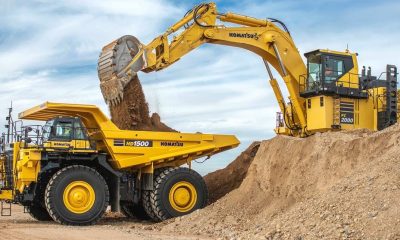
 Tech2 years ago
Tech2 years agoKomatsu launches new HD1500-8E0 rigid-frame dump truck


